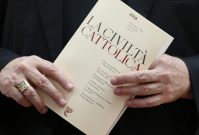Stuck in the Middle with Hayek
In 1944, Friedrich Hayek wrote in “Why the Worst Get on Top” in his The Road to Serfdom:
It seems to be almost a law of human nature that it is easier for people to agree on a negative program—on the hatred of an enemy, on the envy of those better off—than on any positive task. The contrast between “we” and “they,” the common fight against those outside the group, seems to be an essential ingredient in any creed which will solidly knit together a group for common action. It is consequently always employed by those who seek, not merely support of a policy, but the unreserved allegiance of huge masses. From their point of view it has the advantage of leaving them greater freedom of action than almost any positive program.
Eighty years later, Hayek’s observation is still accurate: the worst still get on top by emphasizing their negative program. Where do we see this phenomenon these days? Chances are, you immediately thought of the group about which this is true. Did you think of the Woke Academy or the Evangelical Church? Hayek’s description is, after all, equally applicable to both. While the comparison will annoy people in both communities, as discussed below those two groups are mirror images; left and right get swapped in the mirror, but otherwise the image is the same. They need each other; if one of those groups didn’t exist, the other group would have to invent it.
The importance of this fact was driven home to me while reading Tim Alberta’s The Kingdom, the Power, and the Glory: American Evangelicals in an Age of Extremism. It is a remarkable bit of journalism, organized episodically as Alberta wanders the country going to churches, conventions, and meetings with evangelicals. Chapter by chapter, he allows ample space for assorted parties to explain themselves, what they are thinking, and what they’re trying to do. The portrait of a divided evangelical movement is gripping. If you are interested in the evangelical church, this book is a must-read.
However, the story that Alberta tells has implications that are of national importance, whether or not one is affiliated with the church. What has happened in evangelical churches across the nation bears an uncanny resemblance to the process Hayek describes when he asked why the worst elements of society rose to power in mid-twentieth-century totalitarian countries. Alberta relates an observation made by Cal Thomas, a veteran of Jerry Falwell’s Moral Majority. “One time, I actually asked one of our fundraisers, ‘Why don’t you ever send out a positive letter about what you’re doing with people’s donations?’ And he looked at me with this cynical look. He said, ‘You can’t raise money on a positive. If the goal is bringing in money, you have to scare them.’”
Alberta set out to explore why evangelicals have increasingly become associated with Christian Nationalism and Donald Trump. It is a tale of churches being destroyed by political infighting and the rise of a new set of church leaders. What is different about these new evangelicals is a question Alberta asks repeatedly. One pastor explained the difference: “America. … Too many of them worship America.” Another one related the story of being told, “I’m afraid we have to leave the church after all these decades … because you’re not interpreting the Bible in light of the Constitution.” This belief that politics trumps theology had been growing in evangelical churches for decades, but the dramatic break happened with the Covid lockdowns. Many churches followed government mandates and shut down in-person services for a time. But for churches that decided to openly defy the government rules, their central message was defiance and their congregations grew. Suddenly there were churches where the average congregant was there to hear the 15-minute political rant about the horrors of the political left rather than a 30-minute sermon about the Bible.
The stories Alberta tells are interesting, but the most important part of the book is a conversation Alberta relates with a set of prominent evangelicals who vocally oppose the Trumpian wing of evangelicalism:
We all agreed that these ideological diehards whom [David] French was describing were not a majority of the evangelical movement. There is a difference between the people who prefer the 6 p.m. hour of programming at Fox News to those of its cable rivals, and the people who marinate in right-wing misinformation all day long. That latter group, everyone estimated, was still no more than 15 or 20 percent of most church congregations they knew of. The problem is, as [Russell] Moore pointed out, “That vocal minority will always push around a timid majority. The people who care the most usually get what they want.”
It was at that moment I had an epiphany.
I am an evangelical Christian who works at a secular liberal arts college. I am thus personally acquainted with not only this new wing of evangelicals, but also with the woke academy. While the woke movement is incredibly and aggressively vocal on college campuses, it is a minority of the community. There is a very noticeable difference between the generally liberal members of the faculty and student body and the woke activists who capture all the headlines. A good estimate of the size of the latter group is 20 percent.
Looking at the American landscape, we are watching a pair of dueling religious movements consisting of a vocal minority of people using fear of their opponents as a recruitment tool. As John McWhorter documents in Woke Racism, what is happening on college campuses, the rise of what he calls “the Elect,” is not “like” a religion; it actually is a religion. “An anthropologist would see no difference between Pentecostalism and this new form of antiracism.” There is a clergy, an original sin, attempts at evangelism, an apocalyptic narrative, and ostracism of heretics. The stories in Alberta’s book have obvious parallels with this new religion on the Left. Thinking about the evangelical church, David French noted, “If [pastors in evangelical churches] had a just-as-committed twenty percent to push back on [the politicized 15 to 20 percent] the churches would be just fine. But they don’t.” The same thing is true in the academy.
Finding common ground is more important than figuring out the optimal number of tanks and schools to be built.
Why don’t people stand up and oppose this vocal minority? McWhorter provides the obvious explanation. If you dissent from the vocal minority on a college campus, you are certain to be publicly called a racist. Nobody in an academic community wants to be called a racist. So, silence wins out. Flip to the evangelical church and the same phenomenon exists. Dissent from the vocal minority and your faith in Jesus Christ will be instantly and publicly questioned. You will be called a heretic or an apostate. Nobody attending an evangelical church wants to be labeled a non-Christian. Silence wins out.
Alberta asked what it would take to get 20 percent of the people in evangelical churches to push back against the politicized wing of the church. None of the people with whom he was talking had any idea how to do this. McWhorter looks at the Academy and is even less optimistic. His first observation when looking at the future is, “There is no discussion to be had.” There is no point in talking with the Elect. To try to convince them to modify their views is the equivalent of trying to convince an evangelical Christian to abandon Christ.
The politicized evangelicals and the woke academics are both convinced as a matter of deep faith that their beliefs are correct. How then does one engage in these communities in a productive fashion? The epiphany I had when reading Alberta’s book: any attempt to criticize either one of these movements is doomed to failure. These two groups are already spending large amounts of money and political capital to demonize the other side. As Hayek noted, the worst get on top because they are very good at promoting fear and hatred. If you are an evangelical who sets out to criticize the politicized wing of evangelicals, your voice will be instantly lost or co-opted in the cacophony of criticisms from the woke left. Criticize the woke left and you will suddenly find yourself lumped in with Trump supporters or worse. Any criticism of one side is simply feeding its hatred and fear of the other.
Do you really want to get into these rhetorical wars? As Alberta insightfully notes:
Having spent a lifetime immersed inside this world, it was unclear to me what—or, more realistically, who—might help to bring American evangelicalism back from the brink. … The situation seemed almost hopeless. It was an unfair fight for the soul of American Christianity. On one side were decorated veterans of the culture wars, archconservative Christians who live for conflict. Meanwhile, their more “moderate” counterparts—in temperament, not theology—are inherently reluctant to enter the fray. (Those who believe that their struggle is not against flesh and blood, I had learned, were the least likely to struggle against flesh and blood.)
The same thing is true in the academy. Imagine you believe that the reason universities exist is to encourage the dispassionate search for Truth and Beauty. Do you want to spend your time engaged in the messy and comparatively unimportant Battle of the Day? Isn’t it better to retreat to your office and think about more important and beautiful things?
What if it is correct that there is no way to persuade those who have joined the warring parties to abandon their army? If you are in neither camp—and remember if so, you are in the majority of the population—then what can be done? A negative assault on one of the sides does not diminish its power at all; both sides want and need opposition to increase their power and influence.
If it is impossible to persuade people to quit the battlefield, then the challenge before us is how to stop people from joining the fight in the first place. Messages of fear and hatred are powerful influencers. The challenge for the rest of us is articulating why it is better not to go down one of those paths. The true believers on both sides of this war will always be better at the negative messages; that is why the worst get on top. What then is the positive message which will sway people to avoid the cheap dopamine hit from accepting the messages of fear and apocalypse?
This positive message is missing in the current political landscape. The hardest thing about finding a way to articulate this message is that it will necessarily involve subordinating the political issues of the moment to larger concerns. If there is a battle for the country’s soul going on, then it is crucial to convince people to return political debates to their proper place as being of second order in crafting a good life. It is crucial to remember that what unites us as fellow citizens of the country is more important than what divides us. The positive vision of a country united is a difficult vision to sell, but there is no alternative if we are going to avoid having the ranks of the warring camps become a majority of the population.
What then to do? This positive message needs a new articulation. To develop that message, those who are unhappy with the 20 percent on their end of the political spectrum need to find ways to work with people in the other party who are also alienated from the vocal minority on their side. As long as the political landscape looks the way it does, finding common ground is more important than figuring out the optimal number of tanks and schools to be built. The starting place is to keep in mind the wise words of Stealers Wheel:
Clowns to the left of me
Jokers to the right
Here I am
Stuck in the middle with you



